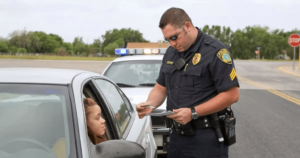When they stop you, why do police officers usually touch the tail lights of the car?
It can be frightening to be pulled over by a police officer. Your mind may rush as the flashing lights reflect off your rearview mirror, and you might notice something strange: the officer is reaching out and touching the tail lights on your car. What makes them act in such way? Is this modest gesture intended to convey a deeper meaning? We’ll learn the intriguing explanations for why police officers usually touch the tail lights of the car during traffic stops in this post.

Recording the Pause
Documenting the contact is one of the most sensible reasons police touch your car’s tail lights. The fingerprint of the police is left on the car when they touch it. This small gesture could have a big impact later on if the interaction gets heated or becomes a fight.
That fingerprint functions as concrete proof that the officer was in fact present at the location, for example, in the event that a motorist speeds off or if concerns are raised over the officer’s behavior. It’s a rapid and simple method of adding accountability and authenticity to the exchange. This may seem unnecessary in the era of body cams, but it is a long-standing custom that has held up throughout time.
Improving Officer Security
Traffic stops are erratic, and each instance is different. Officers are always cautious when approaching any car since they never know what to expect. A basic safety precaution that provides protection in case something goes wrong is touching the tail lights.
Consider the worst-case situation, in which a suspect drives off and an officer gets hurt. forensic teams might be able to put together what happened or identify the car used in a crime with the help of that fingerprint on the tail lights. When reconstructing the sequence of events, the act gives investigators tangible evidence connecting the car to the traffic stop.
Discouragement of Illegal Activity
Touching the tail lights may occasionally serve as a subtly effective deterrent to criminal activity. A driver may become aware that they are being closely watched if they witness the police interacting with their car. It lets them know that the officer is closely observing every aspect of the stop and that whatever they try to conceal or get rid of in the car could end up found out.
This tiny action can deter drivers from trying to conceal illegal drugs, discard contraband, or tamper with the evidence. It serves as a psychological reminder to the police that they are conscious of their surroundings and that anything illegal will not go unpunished.
Developing a Consistency Routine
In order to maintain attention and make sure they cover all the bases during potentially uncomfortable encounters, law enforcement officials mainly rely on routines. During traffic stops, cops frequently follow a set protocol that includes touching the tail lights.

Officers stay grounded and concentrate on the task at hand by carrying out mundane tasks, including touching the tail lights. Behaving consistently reduces the likelihood of mistakes or losing crucial information, particularly under pressure. It guarantees that the officer will approach every stop with the same attentiveness and focus on safety.
Exhibiting Presence and Authority
An officer can also subtly but effectively assert their authority by reaching out to touch the tail lights. Their actions show that they are in command of the circumstance and that they are carefully examining the car. It emphasizes the seriousness of the discussion and gives the driver the impression that the officer is watching every move.
It also lends a formality to the stop by serving as a visual message to anyone observing that law enforcement is carrying out its mandate. With this symbolic action, the driver is reminded that they are in a restricted environment and need to follow the officer’s directions.
A Respect for Cultural Customs in Law Enforcement
The practice of touching a car’s tail lights has become ingrained in some communities or police units. It has evolved into a means of denoting the start of an official conversation between the driver and the police. Some regard it as a gesture of deference, a means of declaring, “We are entering a formal process.”

These customs, while not common, give a human element to the frequently tense and impersonal character of traffic stops. In certain departments, the practice has persisted as a part of the law enforcement culture, handed down through the generations of police.
In summary
Although it can seem like a minor, insignificant gesture to touch a car’s tail lights during a traffic stop, doing so accomplishes several crucial goals. This technique, which is ingrained in law enforcement’s everyday routines, serves a variety of purposes, including documenting the stop with fingerprints, improving officer safety, discouraging unlawful conduct, and maintaining consistency in potentially explosive situations.
Additionally, it upholds the authority of the officer and, in some cases, reflects long-standing cultural customs within the police department. The next time you find yourself at a traffic stop, you will understand that this seemingly insignificant move is actually intended to make the interaction as safe and regulated as possible.
We can better appreciate the levels of safety, responsibility, and tradition ingrained in routine law enforcement operations by comprehending the reasons behind police officers touching the tail lights.
